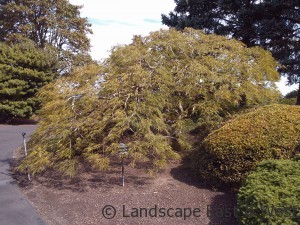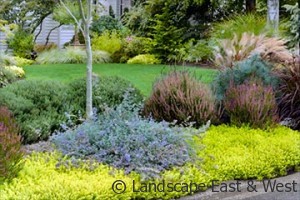Landscape Maintenance Tips for Winter Pruning
 Pruning is one of the most commonly misunderstood aspects of landscaping maintenance. Too often, homeowners simply lop off branches without thinking about how to best help the plant. A lazy or uninformed landscape maintenance service will often take a similar approach by “shaving” bushes with an electric clipper. While this approach certainly creates a uniform shape, it harms the plant by forcing growth at the tips. Over time, this approach causes stagnancy at the center of each plant, which can be fatal. Therefore, careful pruning can help minimize the amount you must spend on replacement plants.
Pruning is one of the most commonly misunderstood aspects of landscaping maintenance. Too often, homeowners simply lop off branches without thinking about how to best help the plant. A lazy or uninformed landscape maintenance service will often take a similar approach by “shaving” bushes with an electric clipper. While this approach certainly creates a uniform shape, it harms the plant by forcing growth at the tips. Over time, this approach causes stagnancy at the center of each plant, which can be fatal. Therefore, careful pruning can help minimize the amount you must spend on replacement plants.
Another common area of confusion has to do with when to prune. Below, we provide landscaping maintenance guidelines for pruning in the winter.
Prune Dead, Diseased or Damaged Branches at any Time of Year
Although dead wood can be cut away at any time of the year, winter is an especially good time to do this, since the lack of leaves makes it easier to see what should be pruned as part of your landscape maintenance.
Portland Roses: Do Not Cut Until After Presidents’ Day
Otherwise, you risk spurring growth in the cold season. Buds that grow in the winter will wither in cold temperatures. To avoid this, prune roses before the first hard freeze, which in Portland is usually in late November.
Prune Trees and Bushes You Want to Encourage
 As your landscape maintenance service provider could explain, summer pruning slows down the following year’s growth by limiting the amount of leaves available to take in food for dormant storage in the roots, while winter pruning encourages strong spring growth by limiting the number of buds that must be nourished. (Evergreens are the exception – they store food in their needles and branches all year long, so pruning will have the same effect on them regardless of when it’s done.)
As your landscape maintenance service provider could explain, summer pruning slows down the following year’s growth by limiting the amount of leaves available to take in food for dormant storage in the roots, while winter pruning encourages strong spring growth by limiting the number of buds that must be nourished. (Evergreens are the exception – they store food in their needles and branches all year long, so pruning will have the same effect on them regardless of when it’s done.)
Prune Crossing Branches
If two branches touch or rub against each other, it’s wise to cut them back now or in early spring.
Clear the Center of Plants with Pruning
Plants thrive when air can easily flow through their centers. Therefore, if the center of a shrub is looking too restricted, cut away some growth there to allow improved circulation.
Avoid Pruning Buds
It’s always best to put off pruning until a shrub or tree is finished flowering. Otherwise, you could severely limit flower production, a basic no-no in landscape maintenance. Portland plants such as forsythia, witch hazel, lilac and plum bloom very early in the year. Prune these and other early-flowering species in the spring, as soon as possible after the plant is done flowering.
Summer- and Fall-Flowering Shrubs
 This group of plants grows flowers on new growth produced in the same season. They flower in May or later. For instance, Beautyberry, Rose of Sharon, abelia and summersweet are summer-blooming plants that landscape maintenance companies should prune back before new growth begins in the spring. (There are some exceptions to this rule; for instance, hydrangeas are summer-blooming plants that should be trimmed back as soon as they’re done flowering.)
This group of plants grows flowers on new growth produced in the same season. They flower in May or later. For instance, Beautyberry, Rose of Sharon, abelia and summersweet are summer-blooming plants that landscape maintenance companies should prune back before new growth begins in the spring. (There are some exceptions to this rule; for instance, hydrangeas are summer-blooming plants that should be trimmed back as soon as they’re done flowering.)
Prune Grapes between January and March
Experts tell us that the majority of residential grape growers are too ginger with their pruning. To maximize productivity, almost all – 90 percent – of the wood produced in the previous season should be cut away. This seemingly draconian landscaping maintenance approach is tailored to the grape’s growing patterns. Buds may sprout from the trunk, canes (long vines that begin at the top of the trunk) and renewal spurs (canes that have been cut back to four or five buds.) With all those buds, it’s not unusual for the grape vine to produce too much new fruit, which is called overbearing. While it may seem like a blessing (who wouldn’t love to have more grapes than expected?) the truth is that fruit quality declines with overbearing. Moreover, the vine will be weakened and fruit ripening will be delayed if you allow a grape to overbear.
In general, if you’re unsure about your variety’s pruning preferences, cane pruning is the safest way to go, so we’ll describe it here. To cane prune, choose two to four fruiting canes to preserve per vine. Prune the length of each cane so as to leave about fifteen buds. If you’re hoping to produce wine grapes, leave about 20-30 buds per plant. Table grapes should be left with 50-80 buds per plant. Also, you’ll want to leave a renewal spur with one or two buds near the trunk; this will be the fruit-producing cane for next year. Trim away all other cane growth.
